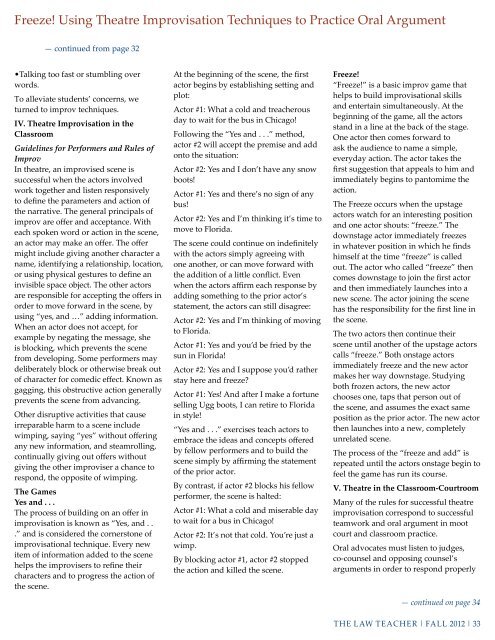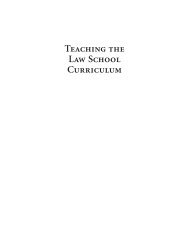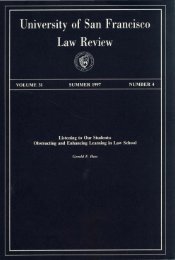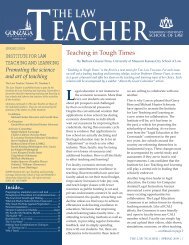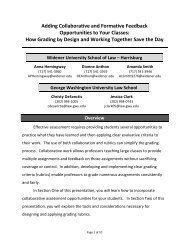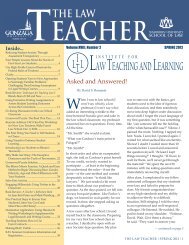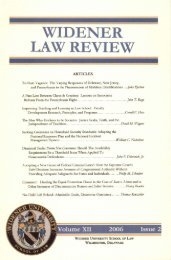The Law Teacher - Institute for Law Teaching and Learning
The Law Teacher - Institute for Law Teaching and Learning
The Law Teacher - Institute for Law Teaching and Learning
You also want an ePaper? Increase the reach of your titles
YUMPU automatically turns print PDFs into web optimized ePapers that Google loves.
Freeze! Using <strong>The</strong>atre Improvisation Techniques to Practice Oral argument<br />
— continued from page 32<br />
•Talking too fast or stumbling over<br />
words.<br />
To alleviate students’ concerns, we<br />
turned to improv techniques.<br />
IV. <strong>The</strong>atre Improvisation in the<br />
Classroom<br />
Guidelines <strong>for</strong> Per<strong>for</strong>mers <strong>and</strong> Rules of<br />
Improv<br />
In theatre, an improvised scene is<br />
successful when the actors involved<br />
work together <strong>and</strong> listen responsively<br />
to define the parameters <strong>and</strong> action of<br />
the narrative. <strong>The</strong> general principals of<br />
improv are offer <strong>and</strong> acceptance. With<br />
each spoken word or action in the scene,<br />
an actor may make an offer. <strong>The</strong> offer<br />
might include giving another character a<br />
name, identifying a relationship, location,<br />
or using physical gestures to define an<br />
invisible space object. <strong>The</strong> other actors<br />
are responsible <strong>for</strong> accepting the offers in<br />
order to move <strong>for</strong>ward in the scene, by<br />
using “yes, <strong>and</strong> …” adding in<strong>for</strong>mation.<br />
when an actor does not accept, <strong>for</strong><br />
example by negating the message, she<br />
is blocking, which prevents the scene<br />
from developing. Some per<strong>for</strong>mers may<br />
deliberately block or otherwise break out<br />
of character <strong>for</strong> comedic effect. Known as<br />
gagging, this obstructive action generally<br />
prevents the scene from advancing.<br />
Other disruptive activities that cause<br />
irreparable harm to a scene include<br />
wimping, saying “yes” without offering<br />
any new in<strong>for</strong>mation, <strong>and</strong> steamrolling,<br />
continually giving out offers without<br />
giving the other improviser a chance to<br />
respond, the opposite of wimping.<br />
<strong>The</strong> Games<br />
Yes <strong>and</strong> . . .<br />
<strong>The</strong> process of building on an offer in<br />
improvisation is known as “Yes, <strong>and</strong> . .<br />
.” <strong>and</strong> is considered the cornerstone of<br />
improvisational technique. every new<br />
item of in<strong>for</strong>mation added to the scene<br />
helps the improvisers to refine their<br />
characters <strong>and</strong> to progress the action of<br />
the scene.<br />
At the beginning of the scene, the first<br />
actor begins by establishing setting <strong>and</strong><br />
plot:<br />
actor #1: what a cold <strong>and</strong> treacherous<br />
day to wait <strong>for</strong> the bus in chicago!<br />
Following the “Yes <strong>and</strong> . . .” method,<br />
actor #2 will accept the premise <strong>and</strong> add<br />
onto the situation:<br />
actor #2: Yes <strong>and</strong> I don’t have any snow<br />
boots!<br />
actor #1: Yes <strong>and</strong> there’s no sign of any<br />
bus!<br />
actor #2: Yes <strong>and</strong> I’m thinking it’s time to<br />
move to Florida.<br />
<strong>The</strong> scene could continue on indefinitely<br />
with the actors simply agreeing with<br />
one another, or can move <strong>for</strong>ward with<br />
the addition of a little conflict. Even<br />
when the actors affirm each response by<br />
adding something to the prior actor’s<br />
statement, the actors can still disagree:<br />
actor #2: Yes <strong>and</strong> I’m thinking of moving<br />
to Florida.<br />
actor #1: Yes <strong>and</strong> you’d be fried by the<br />
sun in Florida!<br />
actor #2: Yes <strong>and</strong> I suppose you’d rather<br />
stay here <strong>and</strong> freeze?<br />
actor #1: Yes! <strong>and</strong> after I make a <strong>for</strong>tune<br />
selling Ugg boots, I can retire to Florida<br />
in style!<br />
“Yes <strong>and</strong> . . .” exercises teach actors to<br />
embrace the ideas <strong>and</strong> concepts offered<br />
by fellow per<strong>for</strong>mers <strong>and</strong> to build the<br />
scene simply by affirming the statement<br />
of the prior actor.<br />
By contrast, if actor #2 blocks his fellow<br />
per<strong>for</strong>mer, the scene is halted:<br />
actor #1: what a cold <strong>and</strong> miserable day<br />
to wait <strong>for</strong> a bus in chicago!<br />
actor #2: It’s not that cold. You’re just a<br />
wimp.<br />
By blocking actor #1, actor #2 stopped<br />
the action <strong>and</strong> killed the scene.<br />
Freeze!<br />
“Freeze!” is a basic improv game that<br />
helps to build improvisational skills<br />
<strong>and</strong> entertain simultaneously. at the<br />
beginning of the game, all the actors<br />
st<strong>and</strong> in a line at the back of the stage.<br />
One actor then comes <strong>for</strong>ward to<br />
ask the audience to name a simple,<br />
everyday action. <strong>The</strong> actor takes the<br />
first suggestion that appeals to him <strong>and</strong><br />
immediately begins to pantomime the<br />
action.<br />
<strong>The</strong> Freeze occurs when the upstage<br />
actors watch <strong>for</strong> an interesting position<br />
<strong>and</strong> one actor shouts: “freeze.” <strong>The</strong><br />
downstage actor immediately freezes<br />
in whatever position in which he finds<br />
himself at the time “freeze” is called<br />
out. <strong>The</strong> actor who called “freeze” then<br />
comes downstage to join the first actor<br />
<strong>and</strong> then immediately launches into a<br />
new scene. <strong>The</strong> actor joining the scene<br />
has the responsibility <strong>for</strong> the first line in<br />
the scene.<br />
<strong>The</strong> two actors then continue their<br />
scene until another of the upstage actors<br />
calls “freeze.” Both onstage actors<br />
immediately freeze <strong>and</strong> the new actor<br />
makes her way downstage. Studying<br />
both frozen actors, the new actor<br />
chooses one, taps that person out of<br />
the scene, <strong>and</strong> assumes the exact same<br />
position as the prior actor. <strong>The</strong> new actor<br />
then launches into a new, completely<br />
unrelated scene.<br />
<strong>The</strong> process of the “freeze <strong>and</strong> add” is<br />
repeated until the actors onstage begin to<br />
feel the game has run its course.<br />
V. <strong>The</strong>atre in the Classroom-Courtroom<br />
Many of the rules <strong>for</strong> successful theatre<br />
improvisation correspond to successful<br />
teamwork <strong>and</strong> oral argument in moot<br />
court <strong>and</strong> classroom practice.<br />
Oral advocates must listen to judges,<br />
co-counsel <strong>and</strong> opposing counsel’s<br />
arguments in order to respond properly<br />
— continued on page 34<br />
<strong>The</strong> <strong>Law</strong> <strong>Teacher</strong> | FaLL 2012 | 33


